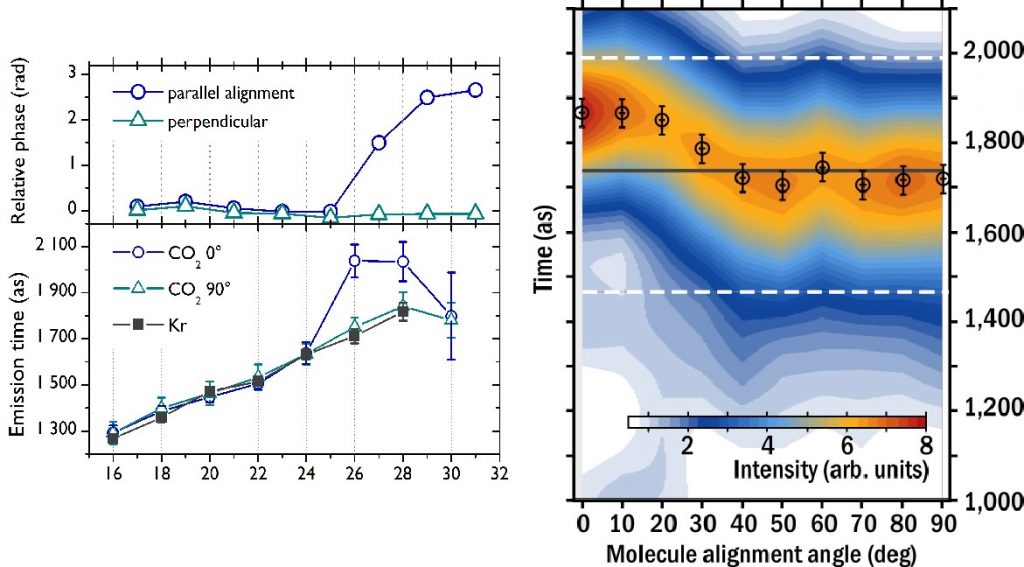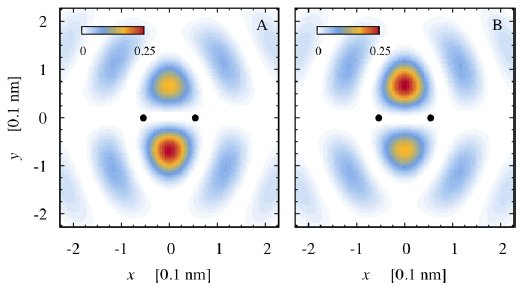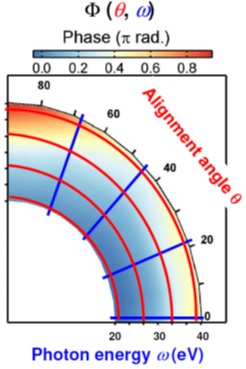Coherent control of attosecond emission from molecules

We have investigated attosecond emission and high-order harmonic generation dynamics in laser-aligned molecules.
In molecules, the nuclear degrees of freedom in a multi-centre system substantially enrich the EWP dynamics, resulting in structural interferences in the recombination step. Moreover, the presence of multiple closely-lying valence states induces multiple ionization and emission channels, resulting in dynamical interferences in the recombination step.
We measured for the first time the phase signature on the harmonic emission of these interference effects (see figure).
This interference effect allows performing a coherent control of the attosecond emission through variation of the alignment angle. This made the cover of the July 2008 issue of Nature Physics.
Reference :
W. Boutu, , S. Haessler, H. Merdji, P. Breger, G. Waters, M. Stankiewicz, L.J. Frasinski, R. Taieb, J. Caillat, A. Maquet, P. Monchicourt, B. Carré, P.Salières, Coherent control of attosecond emission from aligned molecules, Nature Physics 4, 545 (2008).

Attosecond imaging of molecular orbitals
Visualizing the motion of electrons in matter requires both a spatial resolution on the Angstrom scale and a temporal resolution on the attosecond scale. We have demonstrated such an “ultra-fast camera” opening a path towards “viewing the electrons”. It allows imaging molecular orbitals using the ultra-short attosecond emission from this orbital in an intense laser field.
Indeed, the attosecond emission encodes detailed information on the orbitals that radiate , more specifically in the full transition dipole moment – amplitude and phase – which couples the recolliding electron wavepacket to the parent molecular orbitals in the recombination step. Information is reached by analyzing completely the amplitude and the phase of the emitted light in a broad spectral range, for different angles of alignment of the (linear) molecule versus the laser field. One can then reconstruct the orbitals from the dipoles using a tomographic procedure. The possibility of an “Attosecond-Angstrom” imaging is demonstrated in the case of the nitrogen molecule N2.
Reference :
S. Haessler, J. Caillat, W. Boutu, C. Giovanetti-Teixera, T. Ruchon, T. Auguste, Z. Diveki, P. Breger, A. Maquet, B. Carré, R. Taieb, P. Salières, “Attosecond imaging of molecular electronic wavepackets”, Nature Physics 6, 200 (2010).
P. Salières, A. Maquet, S. Haessler, J. Caillat, R. Taïeb, “Imaging orbitals with attosecond and Angström resolutions: toward attosecond chemistry?”, Reports on Progress in Physics 75, 062401 (2012).

Complete characterization of the attosecond emission from aligned molecules
The attosecond emission from aligned molecules encodes a wealth of information on the molecular structure and dynamics with Angström/attosecond resolutions. Up to now, such information was only partially available due to the imperfect characterization of the emission in the parameter space : photon energy and molecular alignement angle with respect to the driving laser polarization. In particular, the emission phase was measured only along one dimension : either along the alignment angle or along the photon energy.
By combining optical interferometry with quantum interferometry in exactly same generation conditions, we could perform the first mapping of the emission phase in two dimensions. The two-source interferometry technique was implemented with a binary diffractive optical element ensuring an efficient and stable measurement of the angular dependence of the phase. Then the RABBIT technique allowed the measurement of the spectral dependence of the phase, providing both a reference in order to connect the angular measurements along the photon energy dimension, but also a high redundancy of information increasing significantly the precision.
These results open the way to high precision measurements in particular of shape and autoionization resonances as well as structural and dynamical interferences in the attosecond emission of a variety of molecules.
References :
- A. Camper, A. Ferré, N. Lin, E. Skantzakis, D. Staedter, E. English, B. Manschwetus, F. Burgy, S. Petit, D. Descamps, T. Auguste, O. Gobert, B. Carré, P. Salières, Y. Mairesse, T. Ruchon, “Transverse Electromagnetic Mode Conversion for High-Harmonic Self-Probing Spectroscopy”, Photonics 2, 184 (2015). DOI: 10.3390/photonics2010184.
- J.B. Bertrand, H.J. Wörner, P. Salières, D.M. Villeneuve, P.B. Corkum, “All-Optical Retrieval of Attosecond Spectral Phase in the Molecular Frame”, Nature Physics 9, 174 (2013).
- S.B. Schoun, A. Camper, P. Salières, R.R. Lucchese, P. Agostini, L. DiMauro, “Precise access to the molecular-frame complex recombination dipole through high-harmonic spectroscopy”, Phys. Rev. Lett. 118, 033201 (2017).
- F. Risoud, C. Lévêque, M. Labeye, J. Caillat, A. Maquet, P. Salières, R. Taïeb, T. Shaaran, “Laser-induced distortion of structural interferences in high harmonic generation”, Scientific Reports 7, 17302 (2017).



